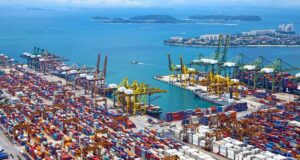During the global supply chain process, container seals and their unique container seal numbers are used to ensure the integrity of a shipment, and to identify if a container has been tampered with during transit.
Container seals are placed onto shipping containers before shipment, and should remain intact until the container reaches it’s final destination.
In international trade, container seals are essential for both security and compliance with customs regulations. They provide shippers, customs authorities, and consignees with peace of mind that the goods have not been tampered with while in transit.
In this article we clarify how container seal numbers work, how they are used throughout the global supply chain, and what to do if a container seal looks like it has been tampered with or broken upon arrival.
What is a Shipping Container Seal?
A shipping container seal is a physical device that is used to secure the doors of a shipping container. Once a container is packed and ready for shipment, a container seal is placed on the outside of the closed shipping container doors to ensure that the cargo inside remains untouched until it reaches its final destination.
Different Types of Container Seals
There are several types of container seals, each serving a different purpose in securing cargo. The most common types include bolt seals, cable seals, plastic seals and wire seals as below.
Bolt Seals: High-security, tamper-evident seals commonly used for international shipping. They include a metal bolt that locks into place, making them hard to break without proper tools.

Cable Seals: Provide a flexible option for securing containers, often used when bolt seals may not be ideal.

Plastic Seals: Lower security seals used for domestic or less sensitive shipments.

Wire Seals: Thin metal wires used for containers where the tamper-evident feature is less critical. They are often used with multiple entry points are required to be sealed. The wire threads through the locking points and can easily show signs of tampering.

What is a Shipping Container Seal Number?
A shipping container seal number is the unique identifying number that is assigned to the corresponding container seal. The container seal is then placed on the external doors of a shipping container once the shipping container is loaded and ready for shipment. The shipping container seal number is a combination of letters and numbers, making each seal number unique.
The shipping container seal number is crucial for tracking the shipment. The seal number is recorded on the shipping documentation, including the Bill of Lading. These documents are used by shipping lines, freight forwarding companies, customs and other authorities to make sure that the container has remained sealed and has not been tampered with during transport.
When the container arrives at it’s destination, customs officials will check the seal number against the records. If the numbers match, and the physical seal does not look to have been damaged or tampered with, it will be approved and the shipment move onto the next stage.
Why are Shipping Container Seals Important?
Shipping container seals are used to secure containers during both domestic and international transport. Once a container is sealed, the seal acts as a lock. This ensures that no one can access the contents without breaking it.
The main reason container seals are important is that they prevent unauthorized access. This means that if anyone tries to open the container without permission, it will be clear because the seal will be broken. The seal number also helps companies and customs officials verify that the container hasn’t been tampered with along its journey.
In addition to security, seals help protect the privacy of the cargo. The seal ensures that the contents of the container remain untouched from the moment it is loaded until it reaches its final destination. This is vital in preventing theft, contamination, or any kind of illegal access.
The container seal is typically placed on the outside right door of the container. Containers usually have two outward-opening doors, and the right door is always opened first. By placing the seal on the right door’s lock rod, it ensures that any attempt to open the container will be immediately evident. This is the standard practice in the industry because it allows for quick visual checks to confirm the container’s security.
In some cases, additional seals may be placed on the left door as an extra precaution. However, for most shipments, placing a seal on the right door is sufficient to ensure that the container remains secure throughout its journey.
International Standards: ISO 17712 for High-Security Seals
ISO 17712 sets the global standard for high-security seals used in shipping. These seals are designed to be tamper-evident, meaning any attempt to open the container without permission will be immediately visible.
They must also meet strict durability and security requirements, including categories of seals, temper evidence, strength testing, certification, marking and identification. Read more about ISO 17712:2013 here.
Who is responsible for putting container seals in place?
The responsibility for placing container seals depends on the type of shipment (FCL: Full Container Load, or LCL: Less than Container Load), and which party is managing the shipment.
FCL (Full Container Load):
For FCL shipments, the shipper is responsible for securing the container with a seal after loading the cargo. The shipper ensures that the container is fully packed and sealed before it is handed over to the shipping line.
LCL (Less than Container Load):
In LCL shipments, multiple shippers’ goods are loaded inside the same shipping container. In this case, it is typically the freight forwarder or the consolidator who is responsible for sealing the container. Since the freight forwarder consolidates goods from various shippers, they seal the container after all the cargo is loaded and ready for shipping.
What Happens if a Container Seal is Broken?
When a container seal is found to be broken or damaged, it doesn’t always mean that illegal activity has occurred. In some cases, customs may have broken the seal to inspect the container’s contents. This is a common practice during international shipments, especially when customs authorities flag a shipment for further inspection.
However, if a container seal appears to be broken or damaged for any reason, it could be a serious issue. The first step is to document the situation and take the necessary steps.
- Photos and Documentation: Take photos of the broken seal and the condition of the container.
- Notify the relevant authorities: Customs or local authorities may need to be involved to investigate tampering or theft. If you are dealing with a freight forwarder, notify them immediately and discuss the next course of action.
- Inspection: The container may have to be inspected to determine if the contents have been tampered with.
Documentation adjustments: The shipping documents may need to reflect any changes in the seal numbers or the issues encountered.
How do I Track a Container with a Seal Number?
To track a container using a seal number, the first step is to access the shipping company’s tracking system.
The container seal number, which is typically listed in key shipping documents, is used to confirm that the container has not been opened or tampered with during its journey. While the container seal number itself may not provide real-time tracking, it serves as a verification tool that helps ensure the container’s security.
For actual shipment and container tracking, you need the container number or a Bill of Lading number. These details allow you to check the container’s location on the relevant tracking platform provided by the freight forwarder, or shipping line. Read more about tracking shipments along the supply chain here.
What is the difference between container number and seal number?
The container number is a unique identifier that is assigned to a specific shipping container. It is used to identify and track the container’s movement across different checkpoints from origin through to final destination. This number remains with the container for its entire lifespan and is displayed visibly on the side of the shipping container. Shipping companies use the container number (or Bill of Lading number) to provide tracking for the location and status of the container.
On the other hand, the seal number is a unique code assigned to the seal used to secure the container’s doors. The seal number changes with each new shipment and is crucial for ensuring the container hasn’t been tampered with during its journey.
Both numbers work together to guarantee the safe and efficient delivery of goods, but they serve different purposes. While the container number tracks the movement of the container, the seal number tracks the security of the cargo inside.
Electronic Container Seals, the Future of Container Seals
As the logistics industry embraces digitized solutions, container seals are evolving to enhance security and efficiency. Traditional physical seals are now being complemented by electronic container seals (e-seals), which are equipped with GPS tracking and real-time monitoring capabilities.
These new e-seals allow for constant surveillance of containers during their journey, helping to detect unauthorized access and deviations from planned routes. Such innovations are part of the broader digital transformation in the shipping industry, where smart containers are being fitted with sensors that monitor conditions like temperature, humidity, and shock.
This shift not only enhances security but also improves supply chain transparency, allowing shippers and consignees to track their goods with greater accuracy. According to industry insights, the implementation of these smart, digitized seals will significantly reduce tampering incidents and improve risk management.







